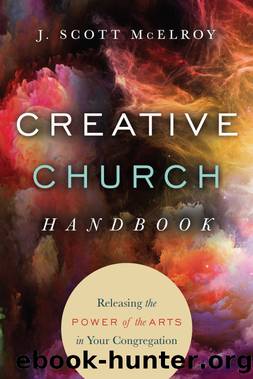Creative Church Handbook by J. Scott McElroy

Author:J. Scott McElroy [McElroy, J. Scott]
Language: eng
Format: epub
ISBN: 9780830897599
Publisher: Inter-Varsity Press
Published: 2015-04-21T00:00:00+00:00
Figure 11.3. Scott Erickson paints live while a speaker delivers his message. Photo used with permission of the artist.
What should the artist paint? The main ways a platform painter knows what to paint is by asking God to give him or her a relevant image and by connecting with the speaker about their topic. Then there is the consideration of what might be appropriate in a particular church setting. If a church is new to live art, then it might be better to paint an image thatâs more easily understood. Consider how people in the back rows will perceive it. At the same time, more artists are finding itâs not necessary to paint literal paintings of biblical events or traditional religious symbols for a painting to be âChristianâ or used by God. Look at Godâs imagination in creating the world and its sometimes fantastical plants and animals. He can speak through images that can be interpreted many different ways, creating a personal impact on many different viewers.
Scott Erickson says, âFor me, live painting is proclamation . . . just like preaching and music. I see it as the visual word, . . . and itâs to be partnered with the verbal word and the musical word. Itâs our jobs as leaders and curators of those proclamation roles to be listening to the Spirit, . . . and if we do, he will give us direction and tie all those elements together for revelation.â3
Should the painting be explained? Given that live art is new in most churches, and Christiansâ general lack of understanding of the arts, I think itâs important to take a moment early on in a service to explain why there is a painter on stage and then to explain the meaning of a painting at the end of a service. We want people to feel welcome in our services. If they see something like this and are confused, it can make them feel uncomfortable. If God has given the artist a special word or interpretation, this can be extremely helpful to the congregation in the moment. And it can cause the painting to speak to someone at another level. Itâs best to limit explanations to two minutes. Any longer and itâs possible for an artist to overexplain the painting, the process or the symbolism and actually become irritating. In churches with an active and established arts ministry, explanation may not always be necessary.
What mediums work best? Many platform painters prefer using acrylic paints because they are water-based, dry quickly and have no fumes. Painters who work with large canvases will often use latex paint from the hardware store. Some will use charcoal or chalk, and occasionally Iâll see someone use watercolor. A few use oils and have found ways around its challenges.4
Most platform artists paint on canvases because thatâs the standard process, plus a painting on canvas looks nice when itâs hung. The drawback is that it can be expensive. One alternative is to buy canvas, build frames, stretch them yourself, then gesso them to take paint, but itâs a process.
Download
This site does not store any files on its server. We only index and link to content provided by other sites. Please contact the content providers to delete copyright contents if any and email us, we'll remove relevant links or contents immediately.
Kathy Andrews Collection by Kathy Andrews(11728)
The remains of the day by Kazuo Ishiguro(8819)
Paper Towns by Green John(5087)
Spare by Prince Harry The Duke of Sussex(5072)
The Body: A Guide for Occupants by Bill Bryson(4974)
Industrial Automation from Scratch: A hands-on guide to using sensors, actuators, PLCs, HMIs, and SCADA to automate industrial processes by Olushola Akande(4972)
Machine Learning at Scale with H2O by Gregory Keys | David Whiting(4175)
Be in a Treehouse by Pete Nelson(3942)
Never by Ken Follett(3788)
Harry Potter and the Goblet Of Fire by J.K. Rowling(3773)
Goodbye Paradise(3726)
Into Thin Air by Jon Krakauer(3308)
The Remains of the Day by Kazuo Ishiguro(3293)
The Cellar by Natasha Preston(3259)
The Genius of Japanese Carpentry by Azby Brown(3224)
Fairy Tale by Stephen King(3218)
120 Days of Sodom by Marquis de Sade(3177)
Drawing Shortcuts: Developing Quick Drawing Skills Using Today's Technology by Leggitt Jim(2996)
The Man Who Died Twice by Richard Osman(2995)
